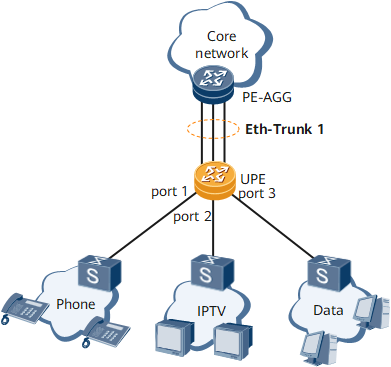Application of Eth-Trunk
Service Overview
As the volume of services deployed on networks increases, the bandwidth provided by a single P2P physical link working in full-duplex mode cannot meet the requirements of service traffic.
To increase bandwidth, existing interface boards can be replaced with interface boards of higher bandwidth capacity. However, this would waste existing device resources and increase upgrade expenditure. If more links are used to interconnect devices, each Layer 3 interface must be configured with an IP address, wasting IP addresses.
To increase bandwidth without replacing the existing interface boards or wasting IP address resources, bundle physical interfaces into a logical interface using Eth-Trunk to provide higher bandwidth.
Networking Description
As shown in Figure 1, traffic of different services is sent to the core network through the user-end provider edge (UPE) and provider edge-access aggregation gateway (PE-AGG). Different services are assigned different priorities. To ensure the bandwidth and reliability of the link between the UPE and the PE-AGG, a link aggregation group, Eth-Trunk 1, is established.
Feature Deployment
- Improved link bandwidth. The maximum bandwidth of the Eth-Trunk link is three times that of each physical link.
- Improved link reliability. If one physical link fails, traffic is switched to another physical link of the Eth-Trunk link.
- Network congestion prevention. Traffic between the UPE and PE-AGG is load-balanced on the three physical links of the Eth-Trunk link.
- Prompt transmission of high-priority packets, with quality of service (QoS) policies applied to Eth-Trunk interfaces.
If devices at both ends of the Eth-Trunk link support the Link Aggregation Control Protocol (LACP), Eth-Trunk interfaces in static LACP mode are recommended.
If the device at either end of the Eth-Trunk does not support LACP, Eth-Trunk interfaces in manual load balancing mode are recommended.
